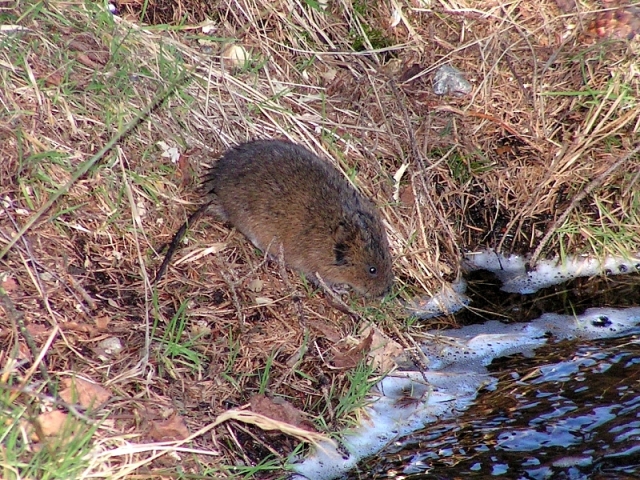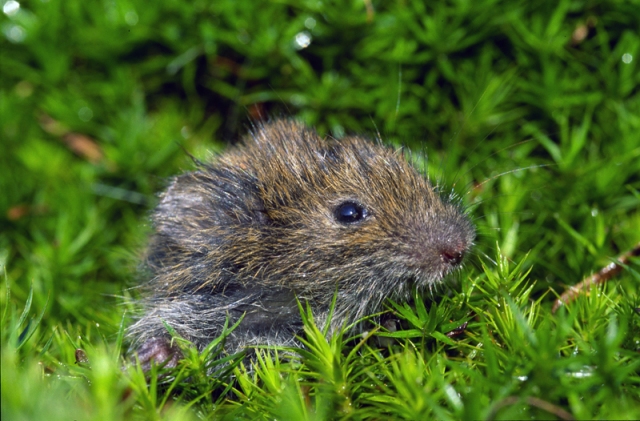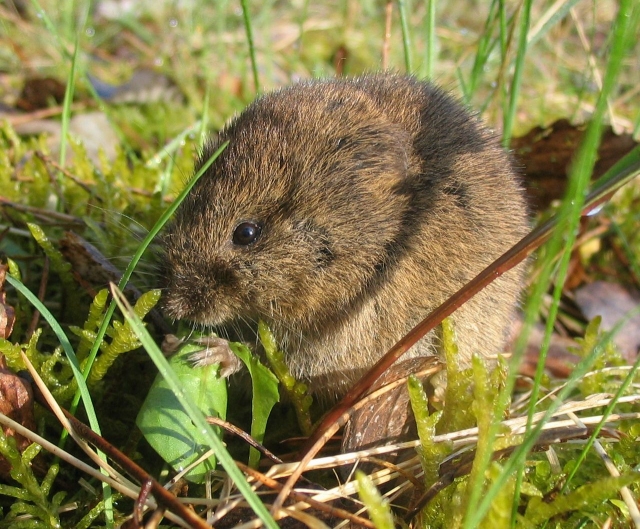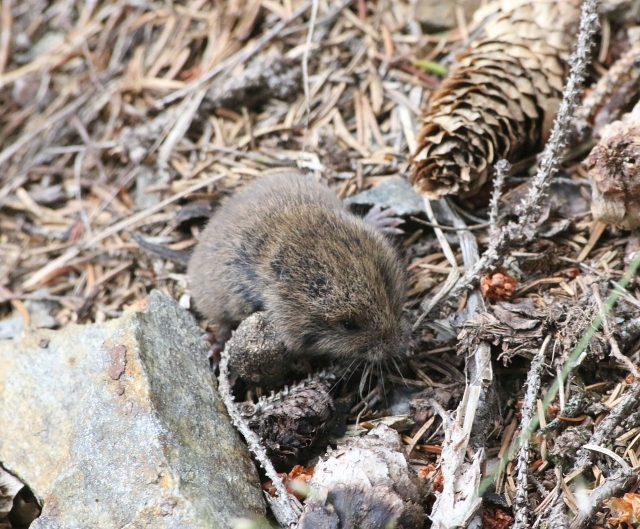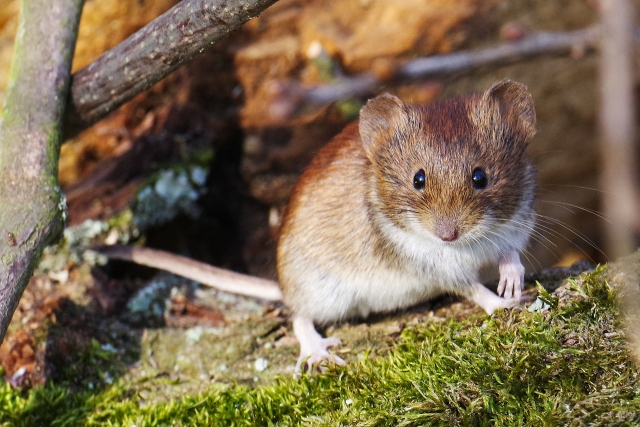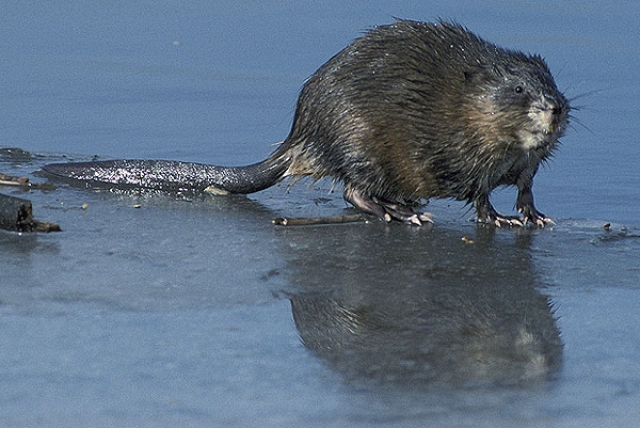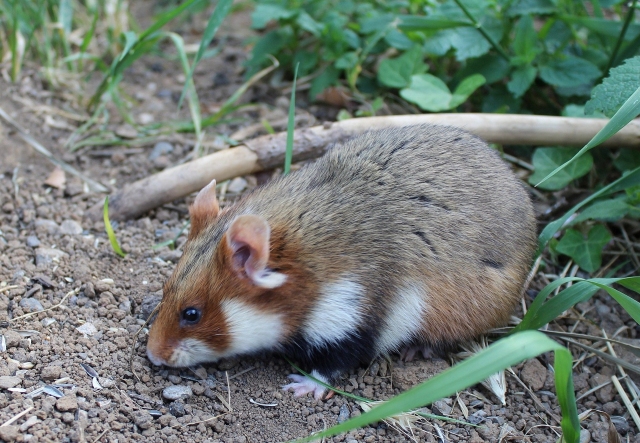Florian Heigl
Montane water vole
Description
The montane water vole was formerly considered a subspecies of the European water vole. The European water vole, which is widespread in Eurasia and lives amphibiously, is larger and has shaggy fur; the montane water vole is a smaller, burrowing species with softer fur, isolated in certain European mountains. The upper incisors of the mountain vole protrude forward and are adapted to the burrowing lifestyle.
Habitat
The main distribution area of the montane water vole is the highlands. There they make extensive burrows, usually no deeper than one metre, in meadows and pastures, more rarely in forests. They are predominantly herbivorous, feeding on plant cover in summer and on roots, root bulbs and tubers in winter.
The text is a translation of an excerpt from Wikipedia (https://de.wikipedia.org/wiki/Gebirgsschermaus). On wikipedia the text is available under a „Creative Commons Attribution/Share Alike“ licence. Status: 20 August 2021
European water vole
Description
European water voles are large, stocky and long-tailed voles and is the second largest vole species in Europe after the introduced muskrat. It has a snout-vent length of 130-165 mm, a tail length of 50-90 mm, and a foot length of 22-27 mm and ear length 12-15 mm.
The coat is long, dense and glossy. It is variable on the upperparts, mostly dark brown, rarely light brown. The tail is lighter. The underpart is whitish or yellowish grey.
Habitat
Depending on the population, the animals live mainly aquatic in rivers, streams and swamps or terrestrial in meadows, orchards and gardens, less frequently in wooded areas.
The text is a translation of an excerpt from Wikipedia (https://de.wikipedia.org/wiki/Ostschermaus). On wikipedia the text is available under a „Creative Commons Attribution/Share Alike“ licence. Status: 20 August 2021
Field vole
Description
The field vole is slightly larger on average than the very similar field mouse and the coat is slightly darker, looser and longer haired. The snout-vent length is 95-133 mm, the tail length 26-47 mm, the length of the hind foot 16-19 mm and the ear length 11-14 mm. The animals weight 20-47 g, rarely up to 55 g. The fur is dark brown on top, occasionally reddish brown. The underpart is whitish, occasionally with a yellowish tinge.
Habitat
The field vole prefers relatively damp and cool habitats, in Central Europe above all sparse forests, clearings, grassy meadows and wet meadows, and of all the small mammals of Central Europe it enters upland moors the furthest. It occurs in the Alps up to 1800 m altitude.
The text is a translation of an excerpt from Wikipedia (https://de.wikipedia.org/wiki/Erdmaus). On wikipedia the text is available under a „Creative Commons Attribution/Share Alike“ licence. Status: 20 August 2021
Field mouse
Description
The snout-vent length is 90-120 mm, the tail length 25-38 mm, the length of the hind foot 14.5-16 mm, rarely up to 17 mm and the ear length 9-12 mm. The animals usually weight 18-40 g, rarely up to 51 g. The coat is yellowish grey on top, more brown in the west of the range, more grey in the east. The underpart is whitish and occasionally rusty yellow.
Habitat
The field mouse mainly inhabits open, agriculturally used cultivated landscapes, i.e. fields, short-grassed meadows and pastures, but also, for example, dunes and dry and very open pine forests.
The text is a translation of an excerpt from Wikipedia (https://de.wikipedia.org/wiki/Feldmaus). On wikipedia the text is available under a „Creative Commons Attribution/Share Alike“ licence. Status: 20 August 2021
European pine vole
Description
The species resembles the field mouse, but is much smaller and has relatively smaller eyes. Snout-vent length is 77-105 mm, tail length 24-40 mm, hind foot length 13.0-16.1 mm and ear length 7-10 mm. The animals weigh 13-23 g. The fur is softer and denser than that of the field mouse and brownish grey on top, the underpart is whitish.
Habitat
In Central Europe, the European pine vole prefers slopes and loose soils with a lot of humus and requires ground vegetation that provides cover; otherwise, however, the species is very adaptable with regard to its habitat requirements. It inhabits forests of all kinds, dry or moist meadows from sea level to above the tree line as well as vegetable gardens and vineyards. Its occurrence in many areas is probably limited less by the habitat features per se than by the presence of other vole species with a similar, partly subterranean way of life.
The text is a translation of an excerpt from Wikipedia (https://de.wikipedia.org/wiki/Kurzohrmaus). On wikipedia the text is available under a „Creative Commons Attribution/Share Alike“ licence. Status: 20 August 2021
Liechtenstein's pine vole
Description
The Liechtenstein´s pine vole is slightly larger than the similar European pine vole. The snout-vent length is 84-115 mm, the tail length 27-45 mm, the length of the hind foot 15-18 mm and the ear length 8-10 mm. The animals weight 14-33 g. The coat is pale yellowish on the upperpart and reddish brown, the underpart and the backs of the feet have whitish hairs. The ears are almost completely hidden in the fur. The skullcap is slightly arched and the ear capsules are relatively large.
Habitat
The relatively small range of the Liechtenstein´s pine vole extends from the Italian Eastern Alps and the extreme south-east of Austria to Istria and the north-western Dinaric Alps in Croatia. In addition, the species is also known from two isolated localities in the northern Alps. It mainly lives in clearings and small meadows with dense ground vegetation in mountain forests, but also in dry meadows and hedgerows from sea level to 1700 m altitude.
The text is a translation of an excerpt from Wikipedia (https://de.wikipedia.org/wiki/Illyrische_Kurzohrmaus). On wikipedia the text is available under a „Creative Commons Attribution/Share Alike“ licence. Status: 20 August 2021
Bank vole
Description
With a snout-vent length of seven to more than 13 cm, this relatively small mouse species has a tail length of 3 to 6.5 cm and weighs between 12 and 35 grams. The species shows size and weight differences of up to 300 percent between populations of different regions.
The dorsal fur is reddish brown to foxy red, sometimes yellowish. The flanks are brownish to grey-brown and usually cream-coloured. The belly coat is whitish to grey. The undercoat is grey. The paws are pale. The black fur at the end of the tail is slightly longer than the rest of the fur on the tail and clearly separated from it in colour. The ears are large to medium sized at nine to 16 mm.
Habitat
Its habitat is formed by beech and mixed forests, hedges and bushes close to forests, and wetlands. It is also often found near watercourses. Gardens close to forests are also accepted as habitats. There, the bank vole also builds its nests in little-used barns, storage sheds, garden huts or other wooden structures. Indications of an existing nest include foliage, dry moss cushions and twigs that have been brought in and deposited by the bank voles.
The text is a translation of an excerpt from Wikipedia (https://de.wikipedia.org/wiki/Rötelmaus). On wikipedia the text is available under a „Creative Commons Attribution/Share Alike“ licence. Status: 20 August 2021
European snow vole
Description
The European snow vole is a relatively large and long-tailed vole. The snout-vent length is 90-140 mm, the tail length 50-76 mm, the length of the hind foot 17.0-22.5 mm and the ear length 13-19 mm. The animals weigh 19-60 g, rarely up to 68 g. As in all species of the genus Chionomys, the fur is soft and dense, light grey on top with a brownish tinge, the underpart is whitish. The upperparts of the feet and the ears have short white hairs, the tail also has white hairs and a white end tassel. The whiskers are also very long, typical of the species, over 35 mm long.
Habitat
Unlike most voles, the European snow vole is bound to soils interspersed with rock and coarse stone and is the only European vole to occur in the high mountains. The snow vole inhabits the Alps at altitudes between 1000 and 4000 m, other mountains up to 4700 m altitude. It inhabits mainly alpine mats and heaps of coarse debris above the tree line. Especially in the Mediterranean region, however, the species also inhabits dry and rocky slopes with shrubbery or loose tree cover and is already present there at altitudes from 125 to 250 m. Occasionally, the animals also inhabit mountain huts and other buildings.
The text is a translation of an excerpt from Wikipedia (https://de.wikipedia.org/wiki/Schneemaus). On wikipedia the text is available under a „Creative Commons Attribution/Share Alike“ licence. Status: 20 August 2021
Muskrat
Description
With a snout-vent length of about 35 cm and a tail length of about 22 cm, the muskrat is smaller than a nutria (Myocastor coypus) or a beaver (Castor fiber) and larger than a brown rat (Rattus norvegicus). The weight is usually between 0.8 and 1.6 kg (maximum: 2.3 kg). The muskrat has a stocky, rat-like shape. The short and thick head merges externally into the rump without a neck. The tail is almost naked and not round but flattened.
The muskrat is excellently adapted to life in the water. It has ears that can be closed watertight, with the auricles hidden deep in the fur. Although its hind paws, unlike those of beavers and nutrias, do not have webbed feet, the muskrat is a skilled swimmer and diver. Instead of webbed toes, muskrats have so-called webbed bristles: stiff hairs that grow as a fringe along the edges of the toes, thus enlarging them like paddles. The main impulse for locomotion in the water is provided by the long, strong legs and the widely spread hind feet. To control and support the swimming movement, the muskrat uses its tail, which it moves to the right and left in a horizontal plane. Its fur is very dense and water-repellent, so it can often stay in the water for long periods.
Habitat
Muskrats spend most of their time in water. They are excellent swimmers and can dive for up to ten minutes. On land, however, the muskrat appears rather clumsy. The shy animal accepts almost any reasonably suitable flowing and still water as a habitat. Muskrats are usually nocturnal and crepuscular. However, as with many other species, such as the red fox and wild boar, their day and night rhythms are dependent on human disturbance. In areas where they are relatively undisturbed, they can often be seen during the day.
The text is a translation of an excerpt from Wikipedia (https://de.wikipedia.org/wiki/Bisamratte). On wikipedia the text is available under a „Creative Commons Attribution/Share Alike“ licence. Status: 20 August 2021
European hamster
Description
European hamsters reach a snout-vent length of 20 to 34 cm, with a 4 to 6 cm long, almost hairless tail. The weight of adult animals varies between 200 and 650 g. Males are usually larger and heavier than females. The hamster is considered the most colourful European fur-bearing animal. The fur colouration is variable: the most common form is a yellow-brown upperpart and a dark, almost black underpart. There are several white patches on the flanks, on the cheek, in front of and behind the forelegs. The striking counter-colouration (back lighter than belly) is plausibly explained by the fact that a hamster, when it can no longer flee, rears up to defend itself: the black belly imitates the mouth of a larger predator with the four white paws as "fangs". The region around the snout and around the eyes is reddish brown in colour, the feet and the tip of the nose are again white. There are also melanistic (almost entirely black) and strikingly light-coloured field hamsters. The undercoat is uniformly grey. All hamster species have well-developed, expandable cheek pouches, which they sometimes use to carry up to five kg of grain into their burrow, even though they only need two kg of food to survive the winter. The feet are broad and have well-developed claws.
Habitat
They are typical ground dwellers and are found almost exclusively in loess and clay soil.
The text is a translation of an excerpt from Wikipedia (https://de.wikipedia.org/wiki/Feldhamster). On wikipedia the text is available under a „Creative Commons Attribution/Share Alike“ licence. Status: 20 August 2021


